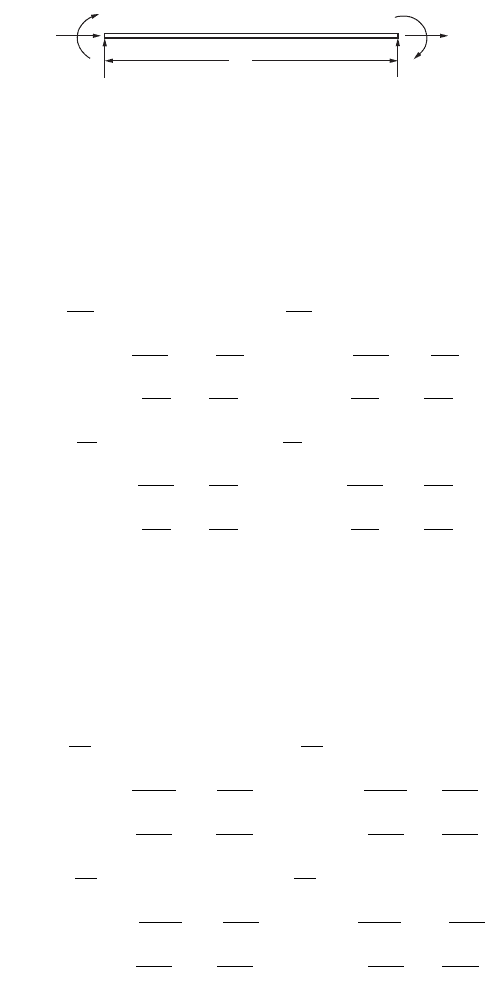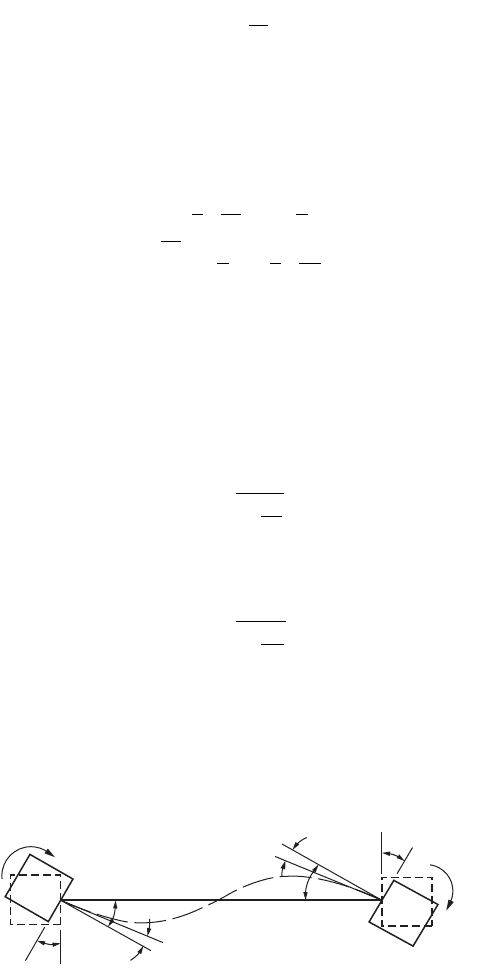Wai-Fah Chen.The Civil Engineering Handbook
Подождите немного. Документ загружается.


Theory and Analysis of Structures 47-81
The terms in the first column consist of the element forces q
1
through q
4
that result from displacement
d
1
= 1 when d
2
= d
3
= d
4
= 0. This means that a unit vertical displacement is imposed at the left end of
the member, while translation at the right end and rotation at both ends are prevented, as shown in
Fig. 47.74. The four member forces corresponding to this deformation can be obtained using the moment
area method.
The change in slope between the two ends of the member is zero, and the area of the M/EI diagram
between these points must therefore vanish. Hence
and
(47.135)
The moment of the M/EI diagram about the left end of the member is equal to unity. Hence
and in view of Eq. (47.135),
Finally, moment equilibrium of the member about the right end leads to
FIGURE 47.74 Beam element — stiffness matrix.
L
(a)
Flexural element
δ
1
δ
2
δ
4
δ
3
q
3
k
21
k
11
k
31
k
22
k
41
k
12
k
42
k
32
k
34
k
14
k
43
k
33
k
23
k
13
k
24
k
44
q
4
q
2
q
1
L
L
L
(c)(b)
(d) (e)
L
δ
1
= 1
δ
3
= 1
δ
2
= 1
δ
4
= 1
k
41
EI
k
42
EI
k
22
EI
k
24
EI
k
43
EI
k
23
EI
k
44
EI
k
21
EI
KL KL
41 21
2EI 2EI
0-=
KK
21 41
=
KL KL
41 21
2EI
2L
32EI
L
3
1
Ê
Ë
Á
ˆ
¯
˜
-
Ê
Ë
Á
ˆ
¯
˜
=
KK
EI
L
41 21
2
6
==
K
KK
11
21 41
=
+
=
L
12EI
L
3
© 2003 by CRC Press LLC

47-82 The Civil Engineering Handbook, Second Edition
and from equilibrium in the vertical direction we obtain
The forces act in the directions indicated in Fig. 47.74b. To obtain the correct signs, one must compare
the forces with the positive directions defined in Fig. 47.74a. Thus
The second column of the stiffness matrix is obtained by letting d
2
= 1 and setting the remaining three
displacements equal to zero, as indicated in Fig. 47.74c. The area of the M/EI diagram between the ends
of the member for this case is equal to unity, and hence
The moment of the M/EI diagram about the left end is zero, so that
Therefore, one obtains
From vertical equilibrium of the member,
and moment equilibrium about the right end of the member leads to
Comparison of the forces in Fig. 47.74c with the positive directions defined in Fig. 47.74a indicates that
all the influence coefficients except k
12
are positive. Thus
Using Figs. 47.74d and e, the influence coefficients for the third and fourth columns can be obtained.
The results of these calculations lead to the following element stiffness matrix:
(47.136)
KK
EI
L
31 11
3
12
==
KK K K
11 21 31 41
==-=-=
12EI
L
,
6EI
L
,
12EI
L
,
6EI
L
3232
KL
EI
KL
EI
22 42
22
1-=
KL KL
22 42
2EI
L
32EI
2L
3
0
Ê
Ë
Á
ˆ
¯
˜
-
Ê
Ë
Á
ˆ
¯
˜
=
KK
22 42
==
4EI
L
,
2EI
L
KK
12 32
=
K
KK
L
EI
L
12
22 42
2
6
==
_
KKKK
12 22 32 42
=- = = =
6EI
L
,
4EI
L
,
6EI
L
,
2EI
L
22
q
q
q
q
EI
L
EI
L
EI
L
EI
L
EI
L
EI
L
EI
L
EI
L
EI
L
EI
L
EI
L
EI
L
EI
L
EI
L
EI
L
EI
L
1
2
3
4
3232
22
32 3 2
22
1
2
3
12
6126
64 6 2
12 6 12 6
62 6 4
È
Î
Í
Í
Í
Í
Í
˘
˚
˙
˙
˙
˙
˙
=
-- -
-
-
-
È
Î
Í
Í
Í
Í
Í
Í
Í
Í
˘
˚
˙
˙
˙
˙
˙
˙
˙
˙
d
d
d
d
44
È
Î
Í
Í
Í
Í
Í
˘
˚
˙
˙
˙
˙
˙
© 2003 by CRC Press LLC

Theory and Analysis of Structures 47-83
Note that Eq. (47.135) defines the element stiffness matrix for a flexural member with constant flexural
rigidity EI.
If the axial load in a frame member is also considered, the general form of an element stiffness matrix
for an element shown in Fig. 47.75 becomes
or
(47.137)
The member stiffness matrix can be written as
(47.138)
Structure Stiffness Matrix
Equation (47.137) has been expressed in terms of the coordinate system of the individual members. In
a structure consisting of many members there would be as many systems of coordinates as the number
of members. Before the internal actions in the members of the structure can be related, all forces and
deflections must be stated in terms of one single system of axes common to all — the global axes. The
transformation from element to global coordinates is carried out separately for each element, and the
resulting matrices are then combined to form the structure stiffness matrix. A separate transformation
matrix [T] is written for each element, and a relation of the form
FIGURE 47.75 Beam element with axial force.
L
E,A,I
q
1
q
2
q
3
q
4
q
5
q
6
q
q
q
q
q
q
EA
L
EA
L
EI
L
EI
L
EI
L
EI
L
EI
L
EI
L
EI
L
EI
L
EI
L
EI
L
EI
L
EI
L
EI
L
EI
L
EI
L
EI
1
2
3
4
5
6
32 32
22
32 3 2
2
00 00
0
12 6
0
12 6
0
64
0
62
00 00
0
12 6
0
12 6
0
62
È
Î
Í
Í
Í
Í
Í
Í
Í
Í
˘
˚
˙
˙
˙
˙
˙
˙
˙
˙
=
-
---
-
-
-
-
LL
EI
L
EI
L
0
64
2
1
2
3
4
5
6
È
Î
Í
Í
Í
Í
Í
Í
Í
Í
Í
Í
Í
Í
Í
˘
˚
˙
˙
˙
˙
˙
˙
˙
˙
˙
˙
˙
˙
˙
È
Î
Í
Í
Í
Í
Í
Í
Í
Í
˘
˚
˙
˙
˙
˙
˙
˙
˙
˙
d
d
d
d
d
d
qk
c
[]
=
[]
[]
d
K
GJ
L
GJ
L
EI
L
EI
L
EI
L
EI
L
EI
L
EI
L
EI
L
EI
L
GJ
L
GJ
L
EI
L
EI
L
EI
L
EI
L
EI
L
EI
L
EI
L
EI
L
zz zz
zz zz
zz z z
zz zz
=
-
-
-
-
-- -
-
È
Î
Í
Í
Í
0
00 00
0
12 6
0
12 6
0
64
0
62
00 00
0
12 6
0
12 6
0
62
0
64
32 32
22
22 3 2
22
ÍÍ
Í
Í
Í
Í
Í
Í
Í
Í
Í
˘
˚
˙
˙
˙
˙
˙
˙
˙
˙
˙
˙
˙
˙
˙
© 2003 by CRC Press LLC

47-84 The Civil Engineering Handbook, Second Edition
(47.139)
is written in which [T]
n
defines the matrix relating the element deformations of element n to the structure
deformations at the ends of that particular element. The element and structure forces are related in the
same way as the corresponding deformations as
(47.140)
where [q]
n
contains the element forces for element n and [W]
n
contains the structure forces at the
extremities of the element. The transformation matrix [T]
n
can be used to transform element n from its
local coordinates to structure coordinates. We know, for an element n, that the force–deformation relation
is given as
Substituting for [q]
n
and [d]
n
from Eqs. (47.138) and (47.139), one obtains
or
(47.141)
[K]
n
is the stiffness matrix that transforms any element n from its local coordinate to structure coordi-
nates. In this way, each element is transformed individually from element coordinate to structure coor-
dinate, and the resulting matrices are combined to form the stiffness matrix for the entire structure.
For example, the member stiffness matrix [K]
n
in global coordinates for the truss member shown in
Fig. 47.76 is given as
(47.142)
in which l =cosf
m = sinf.
FIGURE 47.76 Grid member.
y
x
o
∆
i
∆
j
∆
k
∆
p
φ
d
[]
=
[][]
nnn
T D
qTW
nnn
[]
=
[][ ]
qk
nnn
[]
=
[][]
d
TW kT
nn nnn
[][ ]
=
[][][]
D
[] [][][][]
[][][][]
[][]
[] [][][]
WTkT
TkT
K
KTkT
nnnnn
n
T
nnn
nn
nn
T
nn
=
=
=
=
-1
D
D
D
[]K
AE
L
i
j
k
n
=
--
--
--
--
È
Î
Í
Í
Í
Í
Í
˘
˚
˙
˙
˙
˙
˙
lm lm llm
lm m lm m
llmllm
lm m lm m
22
22
22
22
l
© 2003 by CRC Press LLC

Theory and Analysis of Structures 47-85
To construct [K]
n
for a given member, it is necessary to have the values of l and m for the member.
In addition, the structure coordinates i, j, k, and l at the extremities of the member must be known.
The member stiffness matrix [K]
n
in structural coordinates for the flexural member shown in Fig. 47.77
can be written as
(47.143)
where l = cosf and m = sinf.
Example 47.9
Determine the displacement at the loaded point of the truss shown in Fig. 47.78a. Both members have
the same area of cross section: A = 3 and E = 30 ¥ 10
3
.
The details required to form the element stiffness matrix with reference to structure coordinates axes
are listed below (see Fig. 47.78b):
We now use these data in Eq. (47.142) to form [K]
n
for the two elements.
FIGURE 47.77 Flexural member in global coordinate.
Member Length fl mijkl
11090° 011234
2 18.9 32° 0.85 0.53 1256
FIGURE 47.78 Example 47.9.
X
Y
m
n
l
j
k
i
q
1
q
2
q
3
q
4
q
5
q
6
φ
K
AE
L
EI
L
AE
L
EI
L
AE
L
EI
L
symmetric
EI
L
EI
L
EI
L
AE
L
EI
L
AE
L
EI
L
EI
L
AE
L
EI
L
n
z
[]
=
+
-
Ê
Ë
Á
ˆ
¯
˜
+
-
Ê
Ë
Á
ˆ
¯
˜
-- -
Ê
Ë
Á
ˆ
¯
˜
Ê
Ë
Á
ˆ
¯
˜
+
0
12
12 12
6
6
4
0
12 12 6 12
00
22
3
3
22
3
22
22
332
22
3
lm
ml m l
ml
lm ml mlm
---
Ê
Ë
Á
ˆ
¯
˜
-+
Ê
Ë
Á
ˆ
¯
˜
-
Ê
Ë
Á
ˆ
¯
˜
-
Ê
Ë
Á
ˆ
¯
˜
+
Ê
Ë
Á
ˆ
¯
˜
Ê
Ë
Á
ˆ
¯
˜
-
È
Î
Í
Í
Í
ml m l l ml m l
ml ml
AE
L
EI
L
AE
L
EI
L
EI
L
AE
L
EI
L
AE
L
EI
L
EI
L
EI
L
EI
L
EI
L
EI
L
EI
L
zz
12 12
6
12 12
66
26
6
4
3
22
32 3
2
3
22 22
ÍÍ
Í
Í
Í
Í
Í
Í
Í
Í
Í
Í
Í
Í
Í
˘
˚
˙
˙
˙
˙
˙
˙
˙
˙
˙
˙
˙
˙
˙
˙
˙
˙
˙
7 k
9 k
16 ft
10 ft
3
1
2
2
1
5
1
2
3
4
6
2
1
© 2003 by CRC Press LLC

47-86 The Civil Engineering Handbook, Second Edition
For member 1,
For member 2,
Combining the element stiffness matrices [K]
1
and [K]
2
, one obtains the structure stiffness matrix as follows:
The stiffness matrix can now be subdivided to determine the unknowns. Let us consider D
1
and D
2
, the
deflections at joint 2, which can be determined in view of D
3
= D
4
= D
5
= D
6
= 0 as follows:
or
Example 47.10
A simple triangular frame is loaded at the tip by 20 units of force, as shown in Fig. 47.80. Assemble the
structure stiffness matrix and determine the displacements at the loaded node.
Member Length A I fl m
1722.4 1037 0 1 0
2 101.8 3.4 2933 45° 0.707 0.707
AE
L
330
10
120
750
3
=
¥¥
=
[]
1234
0000
0 750 0 750
0000
0 750 0 750
1
2
3
4
1
K =
-
-
AE
L
330
10
18.9 12
397
3
=
¥¥
¥
=
[]
1256
286 179 286 179
179 111 179 111
286 179 286 179
179 111 179 111
1
2
5
6
2
K =
--
--
--
--
W
W
W
W
W
W
1
2
3
4
5
6
1
2
3
4
5
6
286 179 0 0 286 179
179 861 0 750 179 111
000000
0 750 0 750 0 0
286 179 0 0 286 179
179 111 0 0 179 111
È
Î
Í
Í
Í
Í
Í
Í
Í
Í
˘
˚
˙
˙
˙
˙
˙
˙
˙
˙
=
--
---
-
--
--
È
Î
Í
Í
Í
Í
Í
Í
Í
Í
˘
˚
˙
˙
˙
˙
˙
˙
˙
˙
È
Î
Í
Í
D
D
D
D
D
D
ÍÍ
Í
Í
Í
Í
Í
˘
˚
˙
˙
˙
˙
˙
˙
˙
˙
D
D
1
2
1
286 179
179 861
9
7
È
Î
Í
˘
˚
˙
=
È
Î
Í
˘
˚
˙
-
È
Î
Í
˘
˚
˙
-
D
D
1
2
0 042
0 0169
=
=
.
.
© 2003 by CRC Press LLC

Theory and Analysis of Structures 47-87
For members 1 and 2 the stiffness matrices in structure coordinates can be written by making use of
Eq. (47.143):
and
Combining the element stiffness matrices [K]
1
and [K]
2
, one obtains the structure stiffness matrix as
follows:
FIGURE 47.79 Example 47.10.
2
1
1
2
3
6 ft
20 kips
45°
1
2
3
4
5
6
7
8
9
[]K
1
3
10
12 3 4 5 6
10 0 10 0
01 36 0136
0361728 0 36 864
1 0010 0
013601 36
036864 0 36 1728
1
2
3
4
5
6
=¥
-
-
-
-
-- -
-
Í
Î
Í
Í
Í
Í
Í
Í
Í
Í
Í
˙
˚
˙
˙
˙
˙
˙
˙
˙
˙
˙
[]K
2
3
10
12 3 78 9
10 3610 36
013601 36
36 36 3457 36 36 1728
10 36 10 36
01 3601 36
36 36 1728 36 36 3457
1
2
3
7
8
9
=¥
-- -
--
-
--
--
Í
Î
Í
Í
Í
Í
Í
Í
Í
Í
Í
˙
˚
˙
˙
˙
˙
˙
˙
˙
˙
˙
[]K =¥
-- - -
-
---
-
-- -
-
-
--
-
È
Î
Í
Í
Í
Í
Í
Í
Í
Í
10
20 3610 01036
02720 136 0 1 36
36 72 5185 0 36 864 36 36 1728
1 0010 0 0 0 0
013601 36 0 0 0
036864 0 36 1728 0 0 0
10 36 0 0 0 1000 0 36
01 3600 00136
36 36 1728 0 0 0 36 36 3457
3
ÍÍ
Í
Í
Í
˘
˚
˙
˙
˙
˙
˙
˙
˙
˙
˙
˙
˙
˙
1
2
3
4
5
6
7
8
9
© 2003 by CRC Press LLC

47-88 The Civil Engineering Handbook, Second Edition
The deformations at joints 2 and 3 corresponding to D
5
to D
9
are zero, since joints 2 and 4 are restrained
in all directions. Canceling the rows and columns corresponding to zero deformations in the structure
stiffness matrix, one obtains the force–deformation relation for the structure:
Substituting for the applied load F
2
= –20, the deformations are given as
or
Loading between Nodes
The problems discussed so far have involved concentrated forces and moments applied only to nodes.
But real structures are subjected to distributed or concentrated loading between nodes, as shown in
Fig. 47.80. Loading may range from a few concentrated loads to an infinite variety of uniform or
nonuniform distributed loads. The solution method of matrix analysis must be modified to account for
such load cases.
One way to treat such loads in the matrix analysis is to insert artificial nodes, such as p and q, as
shown in Fig. 47.80. The degrees of freedom corresponding to the additional nodes are added to the total
structure, and the necessary additional equations are written by considering the requirements of equi-
librium at these nodes. The internal member forces on each side of nodes p and q must equilibrate the
external loads applied at these points. In the case of distributed loads, suitable nodes such as l, m, and
n, shown in Fig. 47.80, are selected arbitrarily and the distributed loads are lumped as concentrated loads
at these nodes. The degrees of freedom corresponding to the arbitrary and real nodes are treated as
unknowns of the problem. There are different ways of obtaining equivalence between the lumped and
the distributed loading. In all cases the lumped loads must be statically equivalent to the distributed
loads they replace.
The method of introducing arbitrary nodes is not a very elegant procedure because the number of
unknown degrees of freedom make the solution procedure laborious. The approach that is of the most
general use with the displacement method is the one employing the related concepts of artificial joint
restraint, fixed-end forces, and equivalent nodal loads.
FIGURE 47.80 Loading between nodes.
F
F
F
1
2
3
3
1
2
3
20 36
0272
36 72 5185
10
È
Î
Í
Í
Í
˘
˚
˙
˙
˙
=
-
-
È
Î
Í
Í
Í
˘
˚
˙
˙
˙
¥
È
Î
Í
Í
Í
˘
˚
˙
˙
˙
D
D
D
D
D
D
1
2
3
1
3
20 36
0272
36 72 5185
10
0
20
0
È
Î
Í
Í
Í
˘
˚
˙
˙
˙
=
-
-
È
Î
Í
Í
Í
˘
˚
˙
˙
˙
¥-
È
Î
Í
Í
Í
˘
˚
˙
˙
˙
-
D
D
D
1
2
3
3
666
23 334
0 370
10
È
Î
Í
Í
Í
˘
˚
˙
˙
˙
=-
È
Î
Í
Í
Í
˘
˚
˙
˙
˙
¥
.
.
.
lqp l m n m
© 2003 by CRC Press LLC

Theory and Analysis of Structures 47-89
Semirigid End Connection
A rigid connection holds unchanged the original angles between interesting members; a simple connec-
tion allows the member end to rotate freely; a semirigid connection possesses a moment resistance
intermediate between those of the simple and rigid connections.
A simplified linear relationship between the moment M acting on the connection and the resulting
connection rotation y in the direction of M is assumed, giving
(47.144)
where EI and L are the flexural rigidity and length of the member, respectively. The nondimension
quantity R, which is a measure of the degree of rigidity of the connection, is called the rigidity index.
For a simple connection, R is zero; for a rigid connection, R is infinity. Considering the semirigidity of
joints, the member flexibility matrix for flexure is derived as
(47.145)
or
(47.146)
where f
1
and f
2
are as shown in Fig. 47.81.
For convenience, two parameters are introduced as follows
and
where p
1
and p
2
are called the fixity factors. For hinged connections, both the fixity factors, p, and the
rigidity index, R, are zero, but for rigid connections, the fixity factor is 1 and the rigidity index is infinity.
Since the fixity factor can vary only from 0 to 1.0, it is more convenient to use in the analyses of structures
with semirigid connections.
FIGURE 47.81 Flexural member with semirigid end connections.
MR
EI
L
=y
f
f
1
2
1
2
1
2
1
3
11
6
1
6
1
3
1
È
Î
Í
˘
˚
˙
=
+-
-+
È
Î
Í
Í
Í
Í
˘
˚
˙
˙
˙
˙
È
Î
Í
˘
˚
˙
L
EI
R
R
M
M
f
[]
=
[][ ]
FM
p
R
1
1
1
1
3
=
+
p
R
2
2
1
1
3
=
+
M
2
M
1
ψ
2
ψ
1
f
1
f
2
f
2
f
1
© 2003 by CRC Press LLC

47-90 The Civil Engineering Handbook, Second Edition
Equation (47.145) can be rewritten to give
(47.147)
From Eq. (47.147), the modified member stiffness matrix [K] for a member with semirigid connections
expresses the member end moments M
1
and M
2
in terms of the member end rotations f
1
and f
2
as
(47.148a)
Expressions for K
11
, K
12
= K
21
, and K
22
may be obtained by inverting matrix [F], thus
(47.148b)
(47.148c)
(47.148d)
The modified member stiffness matrix [K], as expressed by Eq. (47.148a to d), will be needed in the
stiffness method of analysis of frames in which there are semirigid member end connections.
47.10 Finite Element Method
For problems involving complex material properties and boundary conditions, numerical methods are
employed to provide approximate but acceptable solutions. Of the many numerical methods developed
before and after the advent of computers, the finite element method has proven to be a powerful tool.
This method can be regarded as a natural extension of the matrix methods of structural analysis. It can
accommodate complex and difficult problems such as nonhomogenity, nonlinear stress–strain behavior,
and complicated boundary conditions. The finite element method is applicable to a wide range of
boundary value problems in engineering, and it dates back to the mid-1950s with the pioneering work
by Argyris (1960), Clough and Penzien (1993), and others. The method was applied first to the solution
of plane stress problems and extended subsequently to the solution of plates, shells, and axisymmetric
solids.
Basic Principle
The finite element method is based on the representation of a body or a structure by an assemblage of
subdivisions called finite elements, as shown in Fig. 47.82. These elements are considered to be connected
at nodes. Displacement functions are chosen to approximate the variation of displacements over each
finite element. Polynomial functions are commonly employed to approximate these displacements. Equi-
librium equations for each element are obtained by means of the principle of minimum potential energy.
These equations are formulated for the entire body by combining the equations for the individual
elements so that the continuity of displacements is preserved at the nodes. The resulting equations are
solved satisfying the boundary conditions in order to obtain the unknown displacements.
[]F
L
EI
p
p
=
-
È
Î
Í
Í
Í
Í
˘
˚
˙
˙
˙
˙
1
3
1
6
1
6
1
3
1
2
[]KEI
KK
KK
=
È
Î
Í
˘
˚
˙
11 12
21 22
K
p
pp
11
1
12
12
41
=
()
-
KK
pp
12 21
12
6
41
=
()
-
K
p
pp
22
1
12
12
41
=
()
-
© 2003 by CRC Press LLC
